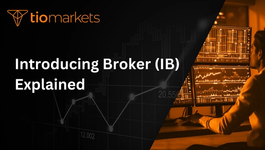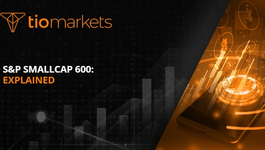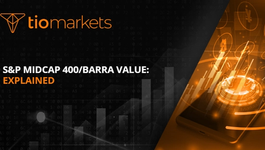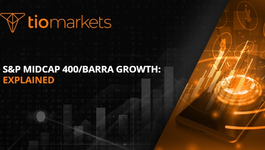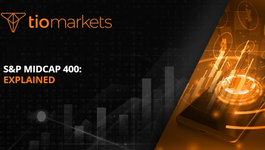NEMAX 50: Explained
BY TIOmarkets
|August 3, 2024The NEMAX 50, also known as the New Market Index, is a stock market index that was used in Germany from 1997 to 2003. It was specifically designed to track the performance of growth-oriented and technology-based companies listed on the Frankfurt Stock Exchange's Neuer Markt. This article will delve into the intricacies of the NEMAX 50, its significance in the trading world, and its impact on the German and global markets.
Understanding the NEMAX 50 requires a comprehensive grasp of its historical context, its operational mechanics, and its role within the broader spectrum of financial indices. This article will provide an in-depth exploration of these aspects, shedding light on the complexities and nuances of this influential index.
Historical Context of the NEMAX 50
The NEMAX 50 was launched in 1997, during a period of rapid technological advancement and economic growth. The index was designed to capture the dynamism of the emerging technology sector, providing investors with a benchmark for tracking the performance of high-growth, technology-oriented companies. The NEMAX 50 was part of the Neuer Markt, a segment of the Frankfurt Stock Exchange dedicated to innovative and growth-oriented companies.
However, the NEMAX 50's existence was relatively short-lived. The index was discontinued in 2003 following the burst of the dot-com bubble and the subsequent decline in the value of technology stocks. Despite its brief lifespan, the NEMAX 50 left a significant mark on the German and global financial markets, and its legacy continues to influence trading strategies and market analyses today.
The Launch of the NEMAX 50
The NEMAX 50 was launched with the aim of providing a platform for innovative, high-growth companies to raise capital. The index was part of the Neuer Markt, a segment of the Frankfurt Stock Exchange that was established to attract technology-focused companies and growth-oriented startups. The NEMAX 50 offered these companies an opportunity to gain visibility and attract investment, thereby fueling their growth and innovation.
The launch of the NEMAX 50 was met with significant enthusiasm from investors and companies alike. The index quickly became a popular investment vehicle, attracting a diverse range of investors from institutional investors to individual retail investors. The NEMAX 50's rapid rise reflected the optimism and exuberance of the late 1990s tech boom, a period characterized by high expectations for the transformative potential of technology and the internet.
The Demise of the NEMAX 50
The NEMAX 50's demise was a direct result of the burst of the dot-com bubble in the early 2000s. The bubble burst led to a sharp decline in the value of technology stocks, causing significant losses for investors and leading to a loss of confidence in the market. As a result, the NEMAX 50, which was heavily weighted towards technology stocks, experienced a dramatic fall in its value.
In response to the market downturn, the Frankfurt Stock Exchange decided to discontinue the NEMAX 50 in 2003. The decision was part of a broader restructuring of the German stock market, which aimed to restore investor confidence and improve market transparency. Despite its discontinuation, the NEMAX 50's impact on the German and global financial markets continues to be felt today.
Operational Mechanics of the NEMAX 50
The NEMAX 50 was a capitalization-weighted index, meaning that the value of each company in the index was determined by the market value of its outstanding shares. This approach ensured that the performance of larger companies had a greater impact on the index's overall performance than smaller companies. The index was calculated on a continuous basis throughout the trading day, providing real-time information on the performance of the constituent companies.
The NEMAX 50 included a diverse range of companies from various sectors, with a particular focus on technology and growth-oriented companies. The index's composition reflected the dynamism and innovation of the late 1990s tech boom, capturing the performance of companies at the forefront of technological advancement and economic growth.
Selection Criteria for the NEMAX 50
The selection of companies for inclusion in the NEMAX 50 was based on a set of specific criteria. These criteria were designed to ensure that the index accurately represented the performance of high-growth, technology-oriented companies. The primary criterion was market capitalization, with a focus on companies with a high market value. Other criteria included the company's growth potential, its financial stability, and its adherence to the transparency and disclosure requirements of the Neuer Markt.
The selection process was overseen by a committee of market experts, who regularly reviewed the index's composition to ensure that it remained representative of the market segment it was designed to track. The committee's decisions were based on a thorough analysis of each company's financial performance, growth prospects, and compliance with market regulations.
Calculation Method of the NEMAX 50
The NEMAX 50 was calculated using a capitalization-weighted methodology. This approach involved multiplying the price of each company's shares by the number of shares outstanding, and then summing these values to obtain the total market capitalization of the index. The index's value was then calculated by dividing this total market capitalization by a divisor, which was adjusted to account for changes in the index's composition, such as the addition or removal of companies.
This calculation method ensured that the index's value accurately reflected the performance of its constituent companies. It also allowed for real-time updates of the index's value, providing investors with up-to-date information on the performance of the market segment tracked by the NEMAX 50.
Significance of the NEMAX 50 in Trading
Despite its relatively short lifespan, the NEMAX 50 played a significant role in the trading world. The index provided a benchmark for tracking the performance of high-growth, technology-oriented companies, offering investors a tool for assessing the health and direction of this market segment. The NEMAX 50 also served as a barometer of investor sentiment towards the technology sector, reflecting the optimism and exuberance of the late 1990s tech boom, as well as the subsequent disillusionment following the burst of the dot-com bubble.
Moreover, the NEMAX 50 offered traders a platform for executing a variety of trading strategies. Traders could invest in the index as a whole, or they could use the index's composition to identify individual companies for investment. The index's volatility also provided opportunities for short-term trading strategies, such as day trading and swing trading.
As a Benchmark for Performance
The NEMAX 50 served as a benchmark for assessing the performance of high-growth, technology-oriented companies. By tracking the performance of these companies, the index provided a measure of the overall health and direction of this market segment. Investors could use the NEMAX 50 to compare the performance of individual companies or portfolios against the broader market, helping them to assess their investment strategies and make informed investment decisions.
The NEMAX 50's role as a benchmark extended beyond the German market. Given the global nature of the technology sector, the index's performance was closely watched by international investors and analysts. The NEMAX 50's performance provided insights into the global technology market, influencing investment decisions and market analyses worldwide.
As a Trading Instrument
The NEMAX 50 was not just a benchmark for performance, but also a trading instrument in its own right. Traders could invest in the index as a whole, providing them with exposure to a diversified portfolio of high-growth, technology-oriented companies. This approach offered a way to invest in the broader market trend, rather than betting on the performance of individual companies.
Moreover, the NEMAX 50's volatility provided opportunities for short-term trading strategies. The index's rapid rise and subsequent fall reflected the volatility of the technology sector, offering traders the potential for high returns (as well as high risks). Traders could capitalize on this volatility through strategies such as day trading and swing trading, which involve buying and selling securities within short timeframes to profit from price fluctuations.
Impact of the NEMAX 50 on the German and Global Markets
The NEMAX 50 had a significant impact on the German and global financial markets. The index's rapid rise and subsequent fall reflected the broader trends in the technology sector, influencing investor sentiment and market dynamics. The NEMAX 50's performance also had implications for market regulation and corporate governance, leading to changes in the way the German stock market operates.
Moreover, the NEMAX 50's legacy continues to be felt today. The index's performance during the late 1990s tech boom and the subsequent dot-com crash serves as a cautionary tale for investors, reminding them of the risks associated with investing in high-growth, technology-oriented companies. The NEMAX 50's history also provides valuable lessons for market regulators and policymakers, informing their efforts to promote market transparency and protect investors.
Impact on Investor Sentiment
The NEMAX 50 had a significant impact on investor sentiment, both in Germany and globally. The index's rapid rise during the late 1990s tech boom fueled optimism and exuberance among investors, leading to a surge in investment in technology stocks. However, the subsequent crash of the dot-com bubble and the sharp decline in the NEMAX 50's value led to a loss of confidence in the market, resulting in a withdrawal of investment and a slowdown in the technology sector.
This shift in investor sentiment had far-reaching implications for the financial markets. It led to a reevaluation of investment strategies, with investors becoming more cautious and risk-averse. It also influenced market dynamics, leading to changes in the pricing and valuation of technology stocks.
Impact on Market Regulation and Corporate Governance
The NEMAX 50's performance also had implications for market regulation and corporate governance. The index's rapid rise and subsequent fall highlighted the risks associated with investing in high-growth, technology-oriented companies, leading to calls for greater market transparency and stronger investor protection measures.
In response to these concerns, the Frankfurt Stock Exchange implemented a series of reforms aimed at improving market transparency and strengthening corporate governance. These reforms included stricter listing requirements for companies, enhanced disclosure requirements, and stronger enforcement of market regulations. These changes have helped to restore investor confidence and improve the functioning of the German stock market.
Lessons from the NEMAX 50
The NEMAX 50's history provides valuable lessons for investors, traders, and market regulators. These lessons relate to the risks and rewards of investing in high-growth, technology-oriented companies, the importance of market transparency and corporate governance, and the role of investor sentiment in driving market dynamics.
By understanding these lessons, market participants can make more informed investment decisions, regulators can design more effective market policies, and companies can better manage their relationships with investors. In this way, the legacy of the NEMAX 50 continues to influence the trading world, shaping the strategies and practices of market participants.
Lessons for Investors and Traders
The NEMAX 50's history provides important lessons for investors and traders. One key lesson is the importance of diversification. The NEMAX 50's sharp decline following the burst of the dot-com bubble highlighted the risks of investing heavily in a single sector, even one as promising as the technology sector. By diversifying their portfolios, investors can spread their risk and protect themselves against market downturns.
Another lesson for investors and traders is the importance of understanding the companies and sectors they invest in. The NEMAX 50's rapid rise was fueled by high expectations for the technology sector, but many investors did not fully understand the business models and growth prospects of the companies they were investing in. By conducting thorough research and analysis, investors can make more informed investment decisions and avoid the pitfalls of irrational exuberance.
Lessons for Market Regulators and Policymakers
The NEMAX 50's history also provides lessons for market regulators and policymakers. One key lesson is the importance of market transparency and corporate governance. The NEMAX 50's rapid rise and subsequent fall highlighted the risks associated with opaque business practices and lax corporate governance. By promoting transparency and strengthening corporate governance, regulators can protect investors and ensure the smooth functioning of the financial markets.
Another lesson for regulators and policymakers is the role of investor sentiment in driving market dynamics. The NEMAX 50's performance demonstrated how optimism and exuberance can fuel market bubbles, while fear and disillusionment can trigger market crashes. By monitoring investor sentiment and responding to market imbalances, regulators can help to stabilize the financial markets and prevent excessive market volatility.
Conclusion
The NEMAX 50, despite its relatively short lifespan, left a significant mark on the trading world. The index's rapid rise and subsequent fall reflected the broader trends in the technology sector, influencing investor sentiment, market dynamics, and regulatory policies. The NEMAX 50's legacy continues to be felt today, providing valuable lessons for investors, traders, and market regulators.
By understanding the NEMAX 50's history, operational mechanics, and impact on the markets, market participants can gain valuable insights into the dynamics of the trading world. These insights can inform their investment strategies, enhance their market analyses, and guide their interactions with the financial markets. In this way, the NEMAX 50 continues to play a role in shaping the trading world, even years after its discontinuation.
Start Trading with TIOmarkets
Now that you've explored the history and lessons of the NEMAX 50, take your trading to the next level with TIOmarkets. As a top-rated forex broker, we offer a robust online trading platform where you can trade over 300 instruments across Forex, indices, stocks, commodities, and futures markets. Benefit from low fees and join a growing community of 170,000+ traders in over 170 countries. Enhance your trading skills with our comprehensive educational resources and step-by-step guides. Ready to embark on your trading journey? Create a Trading Account today and unlock the potential of the financial markets.

Risk disclaimer: CFDs are complex instruments and come with a high risk of losing money rapidly due to leverage. You should consider whether you understand how CFDs work and whether you can afford to take the high risk of losing your money. Never deposit more than you are prepared to lose. Professional client’s losses can exceed their deposit. Please see our risk warning policy and seek independent professional advice if you do not fully understand. This information is not directed or intended for distribution to or use by residents of certain countries/jurisdictions including, but not limited to, USA & OFAC. The Company holds the right to alter the aforementioned list of countries at its own discretion.
Join us on social media

Behind every blog post lies the combined experience of the people working at TIOmarkets. We are a team of dedicated industry professionals and financial markets enthusiasts committed to providing you with trading education and financial markets commentary. Our goal is to help empower you with the knowledge you need to trade in the markets effectively.
